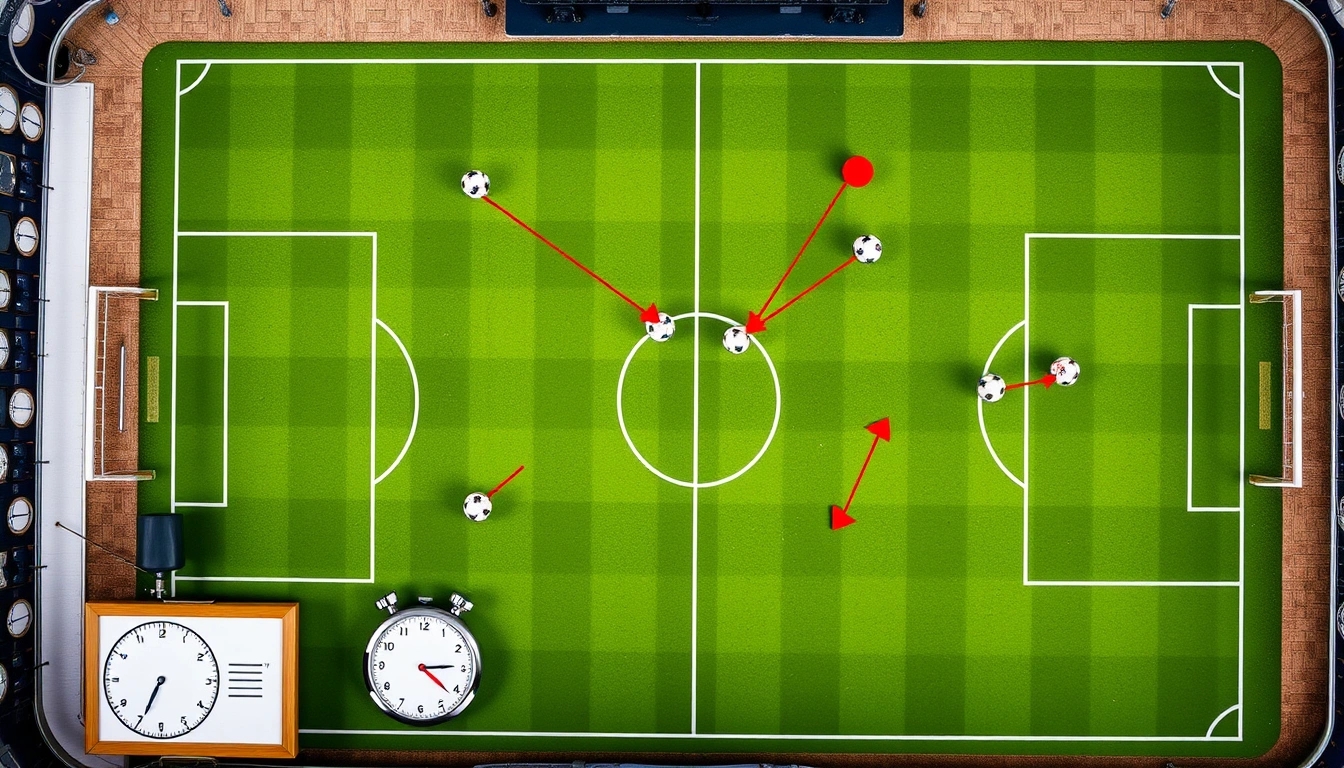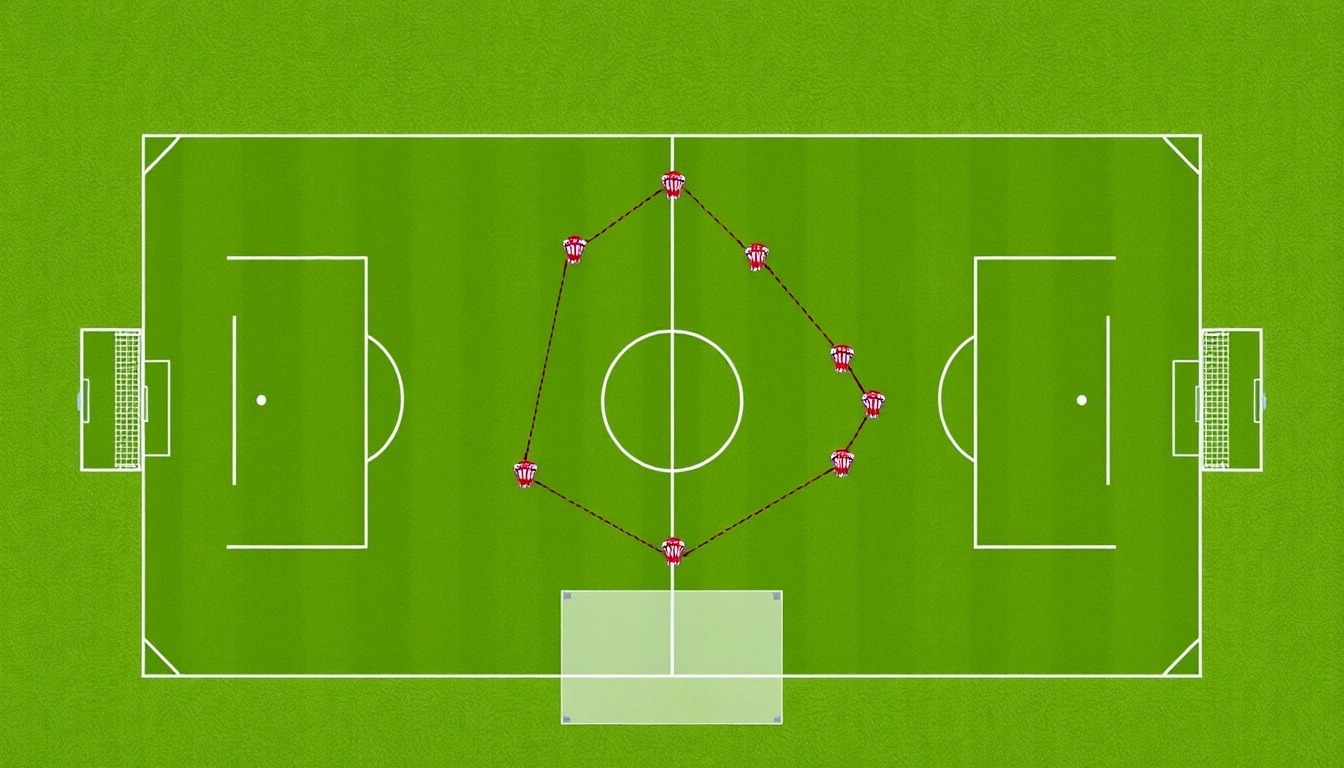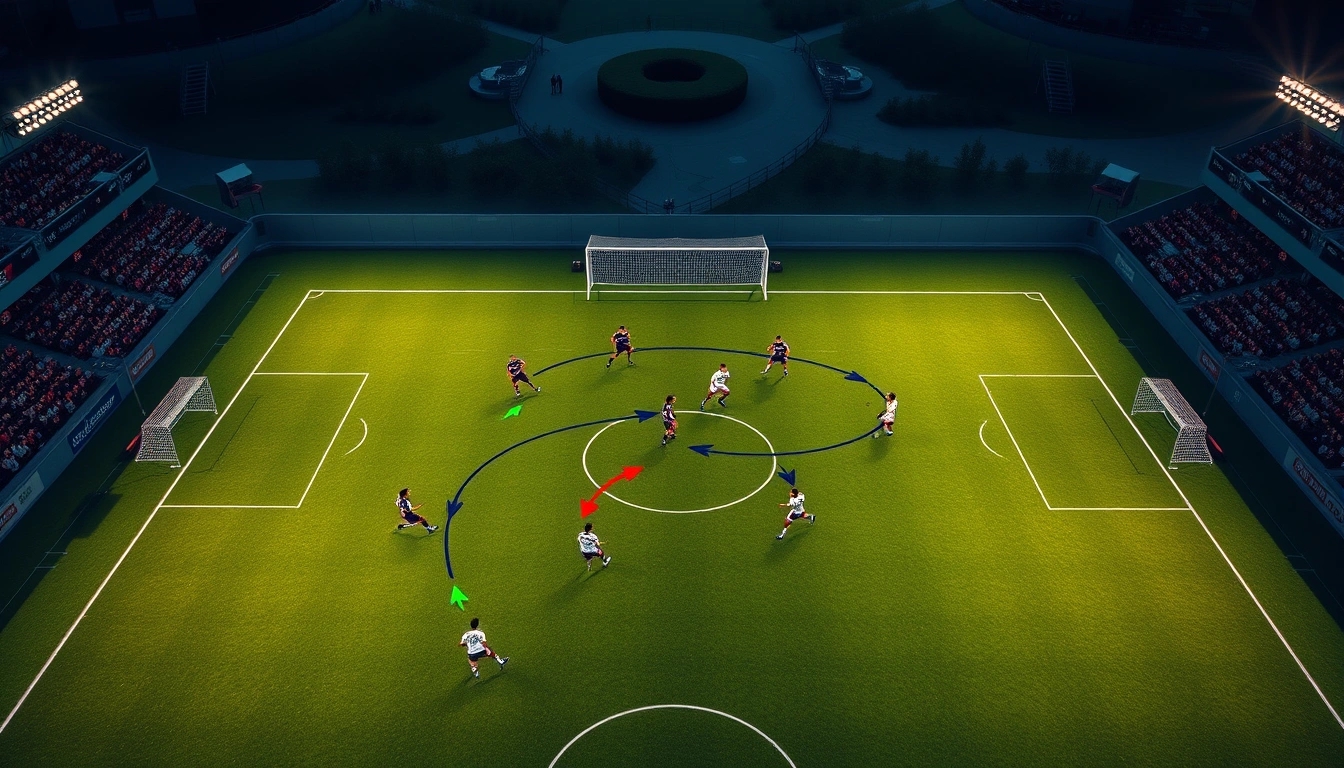Alright, buckle up because we’re diving headfirst into the gritty, stubborn-as-a-mule world of the 5-4-1 formation in soccer. This setup isn’t about flashy goals or relentless attacking flair; it’s about building a fortress, a defensive wall that frustrates opponents to no end. Imagine a team that’s less about scoring and more about making the other side feel like they’re banging their heads against a brick wall. That’s the 5-4-1 for you.
So, what’s the deal with this formation? At its core, the 5-4-1 is a “defense first” strategy, packing five defenders and four midfielders behind a lone striker. Yeah, just one forward to carry the attack, which sounds a bit lonely, but hey, it’s all about keeping things tight at the back. Teams pick this when they want to shut down space, choke the midfield, and dare the opposition to try their luck. It’s like telling your opponent, “Good luck breaking through this mess!”
| Position | Number of Players | Primary Role |
|---|---|---|
| Defenders | 5 | Block attacks, mark strikers, clear balls |
| Midfielders | 4 | Control midfield, support defense, disrupt play |
| Strikers | 1 | Hold up ball, counterattack outlet |
Now, don’t get me wrong — this isn’t some boring, turtle-in-the-shell tactic. The 5-4-1 can be downright ruthless if executed right. The five defenders form a tight line, often with wing-backs who double as midfielders, ready to pounce on any loose ball. Meanwhile, the midfield four aren’t just sitting ducks; they’re the enforcers, breaking up plays and quickly feeding the lone striker when the chance arises.
- Defensive Strengths: It’s damn hard to find space. Opponents get squeezed, passing lanes disappear, and chances dwindle.
- Weaknesses: The lone striker can get isolated, and if the team gets caught on a quick counter, it’s a scramble.
One big gripe critics have is the “too defensive” label. Sure, it can look like a bunker mentality, but savvy coaches know how to flip the script. When the ball is won, that single striker can spring into action, turning defense into a lightning-fast counterattack. It’s like setting a trap: let the opponent push forward, then BAM! Break their rhythm and hit them where it hurts.
Here’s a quick rundown of who does what:
- Wing-backs: Patrol the flanks, balancing defense and surprise attacks.- Central defenders: The backbone, clearing danger and organizing the backline.- Midfielders: The midfield enforcers, disrupting passes and supporting defense.- Lone striker: The hunter, often isolated but crucial for counterattacks.
In short, the 5-4-1 isn’t for the faint-hearted or the “all-out attack” fans. It’s a tactical chess game, demanding discipline, patience, and a bit of grit. If you’re an underdog looking to protect a lead or frustrate a stronger opponent, this formation might just be your best friend. But beware — if your players don’t gel, that lone striker might end up feeling like the only kid left out at recess.
What is the 5-4-1 Formation?
Alright, so you’ve heard about the 5-4-1 formation in soccer, right? If not, buckle up because this setup is like the ultimate “keep it tight, don’t give them an inch” kind of strategy. Imagine a fortress built with five defenders lined up like a brick wall, four midfielders ready to swarm anyone who dares step in, and just one lone striker up front, often left to fend for themselves. Sounds a bit lonely for that striker, but hey, that’s the price of playing defense-first football!
Now, why on earth would a team pick such a seemingly cautious formation? Well, it’s all about frustrating the opposition. You know those days when your team just can’t seem to break through no matter how many shots they take? That’s the 5-4-1 in action. It’s basically a “deny, delay, and disrupt” game plan. Teams use it when they want to shut down the opponent’s attack and make scoring as difficult as possible. Think of it as parking the bus, but with a bit more finesse.
- Five defenders: This includes three central defenders and two wing-backs who can also support the midfield.
- Four midfielders: Usually packed tight, these players act like a second defensive line, clogging the middle of the pitch.
- One striker: The lone wolf, often tasked with holding up the ball or sprinting on counters.
But don’t get me wrong, this isn’t just about being boring or negative. It’s a tactical choice, often used by underdog teams or those protecting a slim lead. The idea is to absorb pressure, stay organized, and then hit back hard when the moment’s right. Opponents hate it because it’s so darn hard to find space or get a clean shot on goal.
| Aspect | Description |
|---|---|
| Defensive Solidity | Five defenders create a strong backline, reducing gaps and blocking attacks. |
| Midfield Support | Four midfielders help shield the defense and disrupt opponent play. |
| Offensive Limitations | Only one striker means fewer attacking options, relying on counters. |
In a nutshell, the 5-4-1 is a defense-first setup that demands discipline and patience. It’s not flashy, it’s not about scoring heaps of goals, but it can win you games by making life miserable for the other side. And sometimes, that’s exactly what you need.
Defensive Strengths of the 5-4-1
Alright, let’s get real about the 5-4-1 formation—this setup is like a brick wall dressed up in cleats. When a team rolls out five defenders and four midfielders, they’re basically telling the opposition, “Good luck finding a way through, because we’ve clogged every damn corridor.” You see, packing the backline with five defenders isn’t just about numbers; it’s about creating a fortress that’s ridiculously hard to crack. The attackers? They end up chasing shadows, running into dead ends, and wondering where the hell all the space went.
- Compactness: The 5-4-1 is all about compactness. The defenders line up close, shoulder to shoulder, leaving almost no gaps between them. This means strikers and wingers have to work overtime to find any breathing room.
- Midfield Shield: The four midfielders act like a second wall, sitting just in front of the defense. They’re not there to play pretty football; they’re there to harass, intercept, and break up attacks before they even get close.
- Wide Coverage: With wing-backs or wide midfielders dropping deep, the flanks get covered like a well-oiled machine. Crosses? Difficult. Overlaps? Nearly impossible.
| Defensive Feature | Effect on Opponents | Why It Works |
|---|---|---|
| Five-Man Backline | Clogs central channels, forces attackers wide | More bodies in defense means fewer gaps to exploit |
| Four Midfielders | Blocks passing lanes, disrupts rhythm | Midfielders double as defensive screen and pressing unit |
| Compact Shape | Limits space between lines | Keeps team tight, reducing chances for through balls |
Now, you might wonder, doesn’t this look a bit… defensive? Yeah, it is. But that’s the whole damn point. The 5-4-1 isn’t about dazzling flair or fancy tiki-taka; it’s about suffocating your opponent’s attack until they’re gasping for air. When attackers try to dribble through, they’re met with a wall of bodies ready to pounce. When they look for passing options, those lanes are clogged tighter than rush hour traffic. It’s like trying to squeeze toothpaste back into the tube—frustrating and mostly pointless.
But here’s the kicker: this setup demands discipline. If one defender steps out of line or a midfielder drifts too far forward, the whole shape can collapse like a house of cards. That’s why communication is key—players have to talk, shout, and practically read each other’s minds to keep this defensive beast intact.
Practical Tips for Players in 5-4-1 Defense:- Stay close, no unnecessary gaps.- Midfielders must track runners relentlessly.- Wing-backs drop quickly to support full-backs.- Always cover for a teammate who steps out.- Anticipate passes; intercept rather than chase.
So yeah, the 5-4-1’s defensive strength lies in its sheer stubbornness. It’s not pretty football, but it’s effective. For attackers, it’s like trying to find a needle in a haystack—if the needle was invisible and the haystack was on fire. And that’s why, when teams want to park the bus or grind out a clean sheet, this formation is their go-to weapon.

Weaknesses and Vulnerabilities
Weaknesses and Vulnerabilities of the 5-4-1 Formation
No system in soccer is foolproof, and the 5-4-1 formation is no exception. While this setup is often praised for its defensive solidity, it has its Achilles’ heel, especially when the opposition decides to hit fast and hard on the counterattack. Imagine a fortress with thick walls but only one gate—if that gate is left open for a second, trouble’s coming. That’s the 5-4-1 in a nutshell.
- Quick Counterattacks: The biggest nightmare for a 5-4-1 defense is a lightning-quick break from the other side. Because the formation prioritizes defense, the midfield often sits deep, which can leave the lone striker stranded up front. When the ball is won in midfield and flicked to speedy attackers, the back five can get stretched thin. Suddenly, the defense is scrambling, and the lone striker is left twiddling thumbs, unable to join the attack effectively.
- Isolation of the Lone Striker: Speaking of the striker, being the only forward in this system can be a lonely gig. If the midfielders don’t push up or support quickly enough, the striker ends up battling multiple defenders alone—an uphill battle that rarely ends well. This isolation reduces offensive threat, making it easier for opponents to sit back and focus on breaking down the defense.
| Vulnerability | Cause | Effect |
|---|---|---|
| Counterattacks | Deep midfield line and slow transition forward | Defense gets stretched, leaving gaps |
| Striker Isolation | Few attacking players and limited midfield support | Reduced offensive pressure, easier to defend |
| Wide Areas | Wing-backs have to cover a lot of ground | Can be exploited by quick wingers |
The wide areas are another spot where the 5-4-1 can get caught napping. Wing-backs have a ton of responsibility: they have to defend solidly but also provide width when attacking. If they get caught too far upfield, the opposition’s wingers or full-backs can exploit the space left behind. You might see the defense getting pulled out of shape as they scramble to cover the flanks.
Now, don’t get me wrong, the 5-4-1 isn’t a busted system by any means. It’s just that it’s like a double-edged sword: it keeps things tight and frustrating for the other team but demands perfect timing and discipline. One slip-up, and boom—counterattack city. The formation’s success often hinges on the team’s ability to transition quickly from defense to offense, which isn’t always easy when you’re sitting so deep.
- Communication Breakdown: Because the formation relies heavily on coordination, any miscommunication between defenders and midfielders can lead to dangerous gaps.
- Fatigue Factor: Constantly defending and chasing balls, especially for wing-backs, can wear players down, leading to lapses late in the game.
In the end, the 5-4-1 is like that stubborn mule—solid and tough but sometimes too rigid to keep up with the fast and furious pace of modern soccer. Coaches who run this formation need to be aware of these weak spots and drill their teams relentlessly on quick transitions and support play. Otherwise, opponents will make them pay, and that fortress could crumble faster than you’d expect.
Player Roles and Responsibilities
Player Roles and Responsibilities in the 5-4-1 Formation
Alright, let’s get down to brass tacks — the 5-4-1 formation isn’t just some random cluster of players on the pitch. It’s a well-oiled defensive machine where every player has a job that, if done right, makes life miserable for the opposition. From the wing-backs hustling up and down the flanks to the midfield enforcers breaking up play like angry bouncers, each role is a vital cog in this fortress.
First up, the five defenders. You’ve got your three central defenders, often the tallest, toughest nuts on the team. Their job? Basically be the wall. They’re the last line before the keeper, tasked with marking strikers, intercepting crosses, and clearing danger like their lives depend on it. The wing-backs, meanwhile, are a bit of a hybrid — part defender, part winger. They need to cover a ton of ground, tracking back to help the defense but also pushing forward to support attacks when the chance arises. It’s a tough gig, and stamina is key here.
| Position | Primary Responsibilities | Key Attributes |
|---|---|---|
| Central Defenders (3) | Mark strikers, block shots, clear crosses, organize backline | Height, strength, positioning, aerial ability |
| Wing-Backs (2) | Defend wide areas, support attacks, track back quickly | Stamina, speed, crossing ability, defensive awareness |
| Midfielders (4) | Control midfield, disrupt opponent’s play, support both defense and attack | Work rate, tackling, passing, positioning |
| Striker (1) | Hold up ball, press defenders, capitalize on counterattacks | Strength, pace, finishing, link-up play |
Moving into midfield, the four players here are often the unsung heroes. Think of them as the engine room. Their job isn’t to dazzle with fancy footwork but to be relentless in winning the ball back, shepherding opponents away from dangerous areas, and recycling possession quickly. Usually, you’ll see two midfielders acting as enforcers — big, tough, and not shy about putting in a crunching tackle — while the other two might be slightly more creative, tasked with launching counterattacks or finding the lone striker with accurate passes.
Now, the lone striker — often a lonely figure, but don’t underestimate the importance here. This player has to be a jack-of-all-trades: able to hold up the ball when the team’s under siege, press defenders to force mistakes, and be clinical when the rare chance to score pops up. It’s a thankless role sometimes, but when done properly, it can be the difference between a frustrating draw and a cheeky win.
- Communication is key: With so many players packed in defense, constant chatter helps keep the shape tight and prevent lapses.
- Discipline over flair: Players must resist the urge to chase glory and stick to their roles, or the whole system falls apart.
- Fitness matters: Wing-backs and midfielders especially need to be fit as fiddles to cover all that ground.
In short, the 5-4-1 is a team effort where selfishness gets you nowhere. Every player’s role is interconnected, like gears in a clock — miss a beat, and the whole thing stutters. But nail it, and you’ve got a defensive setup that’s a nightmare for any attacker trying to break through.
How Teams Transition from Defense to Attack
Alright, so here’s the kicker about the 5-4-1 formation: yeah, it’s built like a brick wall, but it’s not just about parking the bus and hoping for the best. Spoiler alert—teams using this ultra-defensive setup actually have some slick tricks up their sleeves to flip the script and catch opponents off guard. It’s kinda like a tortoise that suddenly sprints when you least expect it. Sounds weird, right? But it’s true.
First off, the 5-4-1 is all about discipline and patience. Those five defenders and four midfielders don’t just sit back and sulk; they’re constantly sizing up the game, waiting for the perfect moment to pounce. When the ball is won back, the transition from defense to attack happens lightning fast, often catching the other team flat-footed. The lone striker up front, while sometimes isolated, becomes a crucial outlet—a target to launch quick counterattacks.
- Quick outlet passes: As soon as possession is regained, defenders or defensive midfielders look for the striker or wingers making runs behind the opposition’s defense.
- Wing-back bursts: The wing-backs, who have been holding their shape defensively, suddenly push forward at pace to create overloads on the flanks.
- Midfield support: Midfielders break forward in support, but cautiously, to avoid getting caught out themselves.
| Phase | Key Actions | Player Roles |
|---|---|---|
| Defensive Setup | Compact shape, blocking passing lanes | 5 Defenders + 4 Midfielders maintain shape |
| Ball Recovery | Intercept or tackle, secure possession | Defensive midfielders & defenders |
| Transition | Fast outlet pass, wing-back runs, striker hold-up | Striker, wing-backs, midfield runners |
| Counterattack | Exploit space behind opponent’s defense | Striker, wingers, advancing midfielders |
Now, here’s where it gets a bit tricky. The success of these counterattacks depends heavily on timing and precision. If the wing-backs blast forward too early or the midfielders get greedy, the team risks getting exposed at the back. It’s a delicate dance—like walking a tightrope while juggling flaming torches. Not for the faint-hearted.
Also, the lone striker isn’t just a lonely figure waiting for scraps. In a well-drilled 5-4-1, this player often doubles as a pivot, holding the ball up to bring others into play or running at defenders to create chaos. The striker’s movement is crucial in dragging defenders out of position, opening pockets of space for those sneaky midfield runners to exploit.
- Practical insight: Teams that master this transition tend to have players with high stamina and good decision-making skills. You can’t just throw anyone into this system and expect magic.
- Fun fact: Some coaches deliberately train their midfielders to “fake” forward runs, freezing defenders and creating openings elsewhere. It’s like a magician’s misdirection in football form.
So, while the 5-4-1 might seem like a fortress built purely to frustrate and soak up pressure, it’s actually a cunning setup that waits for its moment to strike. The key takeaway? Don’t be fooled by the defensive posture—it’s not all doom and gloom. When the opportunity arises, this formation can unleash some seriously swift and sharp counterattacks that leave opponents scratching their heads.
In the end, the 5-4-1 is a bit like that grumpy old defense-first uncle at family dinners—slow to warm up, but when he does, watch out, because he’s got stories (and moves) that can surprise you.

Famous Teams and Coaches Using 5-4-1
Alright, let’s take a little wander down the memory lane and peek into the world of managers and clubs who have taken the 5-4-1 formation under their wing. This setup isn’t exactly the flashiest or the most glamorous, but boy, does it have its die-hard fans. Some swear by it like it’s their lucky charm, others grudgingly accept it as a necessary evil. Either way, it’s fascinating to see who bets on this defensive fortress and how it’s played out on the pitch.
First off, you can’t talk about 5-4-1 without mentioning Jose Mourinho. The self-proclaimed “Special One” has often leaned on this formation when he wants to shut down the opposition and grind out results. Remember his stint at Chelsea or Inter Milan? Mourinho’s teams were masters of parking the bus, frustrating attackers like a mosquito buzzing around your ear at night. It’s not always pretty, but it sure gets the job done. Some critics called it boring, others called it genius. Depends on your mood, really.
| Coach | Team | Notable Usage | Style Impact |
|---|---|---|---|
| Jose Mourinho | Chelsea, Inter Milan | 2000s-2010s | Defensive solidity, counterattack focus |
| Diego Simeone | Atletico Madrid | 2010s-present | Relentless pressing, compact defense |
| Gian Piero Ventura | Italy National Team | 2016-2017 | Defensive caution, risk-averse |
Another name that pops up is Diego Simeone, whose Atletico Madrid sides have often flirted with the 5-4-1 shape. Simeone’s teams are like pit bulls — tough to shake off, well-drilled, and never shy away from a scrap. The 5-4-1 fits perfectly with his philosophy of suffocating opponents and hitting them hard on the break. It’s not just about defense, though; it’s about making the opposition feel like they’re banging their heads against a brick wall.
But hey, it’s not always success stories. Take Gian Piero Ventura’s Italy squad, for example. When he tried to deploy a cautious 5-4-1 approach, it didn’t go down well — the team looked overly defensive, lacked creativity, and eventually failed to qualify for the 2018 World Cup. Ouch. Sometimes, the formation’s defensive stubbornness can backfire spectacularly.
- Why do some coaches love it? Because it’s a pain in the neck for attackers and can grind out results when you’re the underdog.
- Why do others hate it? Because it can be dull, isolating for the striker, and sometimes invites pressure that’s hard to shake off.
In modern football, the 5-4-1 is often a tactical tool rather than a permanent setup. Managers switch to it mid-game when they want to protect a lead or frustrate a dominant opponent. It’s like pulling out the big, rusty hammer when finesse tools won’t do the trick.
Key Takeaways:- Mourinho & Simeone: Use 5-4-1 to frustrate and counterattack.- Ventura: Shows the risks of over-defensive play.- Formation is a double-edged sword: solid but sometimes stifling.
So, whether you love it or hate it, the 5-4-1 formation has carved out a unique niche in football history. It’s the go-to for managers who want to make life miserable for their opponents, and for fans who appreciate a good tactical battle over flashy goals. Just don’t expect fireworks every time you see it on the pitch.
5-4-1 vs Other Defensive Formations
Alright, let’s dive into the nitty-gritty of the 5-4-1 formation and how it stacks up against its cousins, the 4-5-1 and 3-5-2. Now, if you think all defensive formations are just about parking the bus, think again. Each has its own quirks, strengths, and, yep, glaring weaknesses. The 5-4-1, in particular, is like that stubborn mule on the pitch — hard to budge but sometimes a bit too rigid.
- 5-4-1: The Fortress – This setup is all about creating a brick wall. Five defenders, four midfielders sitting deep, and a lone striker who’s often left to fend for himself. The idea? Smother the opposition’s attack, clog every passing lane, and hope your striker can pounce on scraps. It’s ultra-defensive, and honestly, sometimes frustrating to watch because it’s so cautious.
- 4-5-1: Balanced but Flexible – Compared to the 5-4-1, the 4-5-1 drops one defender to add an extra midfielder. This means you get a bit more control in the middle of the park and can transition quicker into attack. The defense isn’t as packed, but midfielders help plug gaps. It’s like having a safety net rather than a fortress.
- 3-5-2: Wing-Back Bonanza – This one’s a bit flashier. Three central defenders, five midfielders (including wing-backs who double as defenders and wingers), and two strikers. It’s more attacking-minded but can be risky at the back. The wing-backs have to run a marathon, and if they get caught upfield, the defense can be exposed.
So where does the 5-4-1 shine or fall flat? Let’s peek at a quick comparison table:
| Aspect | 5-4-1 | 4-5-1 | 3-5-2 |
|---|---|---|---|
| Defensive Solidity | High – Packed defense, hard to break down | Moderate – Balanced midfield helps shield | Moderate to Low – Fewer defenders, wing-backs exposed |
| Midfield Control | Low – Midfielders mostly defensive, limited creativity | High – Extra midfielder aids possession and pressing | High – Wing-backs add width and support |
| Attacking Threat | Low – Lone striker often isolated | Moderate – Midfielders support attack | High – Two strikers plus wing-backs |
| Vulnerability | Counterattacks and isolation of striker | Less exposed but can be outnumbered in defense | Wide areas if wing-backs caught forward |
One thing that’s often overlooked is how psychological the 5-4-1 can be. Opponents get frustrated because they can’t find a crack in the defense. It’s like trying to break into Fort Knox with a toothpick. But on the flip side, your own team might feel a bit shackled — the lone striker looks like he’s waiting for a bus that never comes. And let’s be honest, it can be a bit dull for neutrals.
Here’s a quick rundown of practical insights for coaches thinking about these formations:
- 5-4-1: Use when you want to protect a lead or face a superior attacking team. Communication and discipline are key. Your midfielders must track runners relentlessly.
- 4-5-1: Great for possession-based teams who want defensive cover but also want to control the game’s tempo. Midfielders should be versatile.
- 3-5-2: Best if you have energetic wing-backs and two clinical strikers. Risky but can overwhelm opponents with width and numbers upfront.
In the end, no formation is a magic bullet. The 5-4-1 is a defensive beast, but sometimes that beast can be a bit too stubborn, especially when the game demands creativity or quick transitions. It’s a classic “defense first” approach that works wonders if executed perfectly but can leave you gasping for breath if the opposition pounces on your lone striker’s isolation.
So next time you see a team line up in 5-4-1, don’t just write them off as boring — respect the grind, the discipline, and the sheer tactical willpower it takes to pull it off. But also, don’t expect fireworks. This formation is the soccer equivalent of a slow-burning thriller, not an action blockbuster.
When to Deploy the 5-4-1 Formation
Alright, let’s get real about the 5-4-1 formation—it’s not your run-of-the-mill setup that screams “Let’s go score!” Instead, it’s that stubborn, defensive-minded strategy coaches pull out when the chips are down or when they want to keep the scoreboard intact. You’ll often see this formation pop up in some pretty specific scenarios, and honestly, it’s like the Swiss Army knife for teams that want to grind out results without getting embarrassed.
- Underdog Tactics: Imagine a smaller club facing a football giant. The 5-4-1 is their trusty shield. Packing the defense with five at the back and four midfielders means clogging up the lanes, making the big boys sweat just to get a sniff of goal. It’s less about flair, more about survival. The lone striker might look lonely, but he’s there to pounce on any scraps or counterattack opportunities.
- Protecting a Lead: Got a one-nil advantage? Time to bunker down. The 5-4-1 is perfect for frustrating opponents who are throwing everything forward. You basically tell your players: “Hold the line, don’t give an inch.” It’s like putting a padlock on your net, and the opposition ends up banging their heads against a brick wall.
Now, don’t get me wrong, this formation isn’t just about sitting back and hoping for the best. There’s a sneaky side to it. Teams using 5-4-1 can spring quick counterattacks — the midfield four are not just there to defend, but also to launch rapid breaks. The lone striker? He’s a fox in the box, ready to exploit any mistake. But yeah, if you’re expecting fireworks, you might be disappointed.
| Scenario | Why 5-4-1 Fits | Key Focus |
|---|---|---|
| Facing a Superior Opponent | Maximizes defensive solidity and minimizes space for attackers | Compact defense, quick counters |
| Protecting a Narrow Lead | Shuts down attacking lanes and frustrates the opposition | Discipline, patience, and resilience |
| Playing Away in Tough Matches | Reduces risk by prioritizing defense over attack | Organization and teamwork |
One thing to watch out for: if your lone striker gets isolated for too long, the whole formation can feel a bit… well, lonely. Plus, if the opposition is lightning-fast on counters, your five defenders might get stretched thin. So, it’s not a magic bullet but more like a calculated gamble.
In the end, the 5-4-1 is a tool to be used wisely. It’s perfect when you want to play it safe, frustrate the opposition, or just dig in deep and claw out a result. It’s not flashy or glamorous, but sometimes, grinding out a point or sneaking that one goal is all you need. And hey, sometimes the best defense really is the best offense.

Tips for Coaches and Players Using 5-4-1
Alright, so you’ve decided to roll with the 5-4-1 formation — a real fortress of a setup. But let’s be honest, just lining up five defenders and hoping for the best won’t cut it. There’s a bit of an art to making this system work like a charm, and that’s where some practical advice can save you from a defensive meltdown. Here’s the lowdown, no fluff.
Communication is your secret weapon. When you’ve got nine players packed in defense and midfield, keeping everyone on the same page is crucial. Think of it like a group chat where everyone needs to reply instantly — no ghosting allowed. Defenders and midfielders must constantly shout out coverages, mark switches, and alert teammates about runs. If your backline starts mumbling or zoning out, opponents will sniff blood and slice through you like a hot knife through butter.
- Tip 1: Assign a vocal leader in the back — someone who commands respect and keeps the line organized.
- Tip 2: Use simple, clear calls. Overcomplicating signals just causes chaos.
- Tip 3: Midfielders should act as the link between defense and attack, relaying info quickly.
Now, about positioning tweaks — this isn’t just about standing still in a wall of blue jerseys. The wing-backs aren’t just statues; they need to be ready to sprint up and down like caffeine-fueled maniacs. But here’s the catch: don’t get too greedy pushing forward or you’ll leave gaping holes behind. Striking that balance is a nightmare but totally doable.
| Position | Key Positioning Advice | Common Mistake |
|---|---|---|
| Wing-Backs | Stay wide, track back quickly, and support midfield. | Overcommitting forward, leaving flanks exposed. |
| Central Defenders | Maintain a tight line, communicate constantly, and clear danger. | Getting dragged out of position by quick forwards. |
| Midfielders | Shield defense and be ready to break forward on counters. | Failing to track runners or losing shape. |
Another nugget of wisdom: practice your transitions relentlessly. The 5-4-1 isn’t just a bunker; it’s a springboard for lightning-fast counters. When you win the ball, midfielders and wing-backs need to flip the switch instantly and launch the lone striker into space. Hesitation here is death. Coaches, drill this until players do it in their sleep.
And hey, don’t ignore fitness. This formation demands stamina — especially from wing-backs and midfielders who are basically running marathons every match. If your squad’s gassed by the 60th minute, your fortress crumbles.
- Keep training sessions sharp and focused on endurance.
- Use video analysis to spot positioning errors and fix them ASAP.
- Encourage players to trust each other — a shaky backline is a gift to attackers.
In short, the 5-4-1 isn’t some magic bullet. It needs constant communication, smart positioning, and ruthless work rate. Nail these, and you might just frustrate even the slickest attacking teams into submission. Screw it up, and you’re handing out goals on a silver platter. So, buckle up, coach — this system is a tough nut to crack, but the payoff? Totally worth it.
Frequently Asked Questions
- What makes the 5-4-1 formation so defensively solid?
Think of the 5-4-1 as a brick wall with a moat—five defenders form a tight barrier, while four midfielders act like vigilant guards, cutting off passing lanes and smothering attackers before they get close. This setup frustrates opponents by limiting space and forcing them into risky plays.
- Is the lone striker in a 5-4-1 formation isolated?
It might seem lonely up front, but the striker plays a crucial role as the team’s spearhead. They’re expected to hold up the ball, create chances, and sometimes drop back to help midfielders. Sure, they face challenges, but with good support from midfield, they can be deadly on counterattacks.
- When is the best time to use the 5-4-1 formation?
Imagine you’re the underdog or holding onto a narrow lead—this is when 5-4-1 shines. It’s perfect for soaking up pressure and frustrating more attacking teams. Coaches love deploying it in tough away games or when they want to grind out a result.
- How does the 5-4-1 transition from defense to attack?
Despite its defensive reputation, the 5-4-1 isn’t all doom and gloom. Teams often spring quick counterattacks by launching the ball forward to the lone striker or overlapping wing-backs, catching opponents off guard like a lightning strike.
- What are the weaknesses of the 5-4-1 formation?
No system is perfect. The 5-4-1 can get exposed on fast breaks, especially if the midfielders fail to track back quickly. Also, the lone striker might struggle to hold possession against multiple defenders, limiting attacking options.
- How does 5-4-1 compare to other defensive formations like 4-5-1?
While both formations focus on defense, 5-4-1 adds an extra defender, making it tougher to break down but potentially less flexible going forward. The 4-5-1 offers more midfield control but can leave the backline more vulnerable.
- Who are some famous teams or coaches known for using the 5-4-1?
Managers like José Mourinho and teams that prioritize defensive discipline have famously used the 5-4-1. It’s a go-to for squads wanting to frustrate top-tier opponents and snatch points through tactical resilience.
- What tips can help players excel in the 5-4-1 system?
Communication is king—players must constantly talk and adjust positioning. Wing-backs need to balance defense and surprise attacks, while midfielders must be relentless in tracking runners. Staying disciplined and patient is the secret sauce to mastering this formation.












